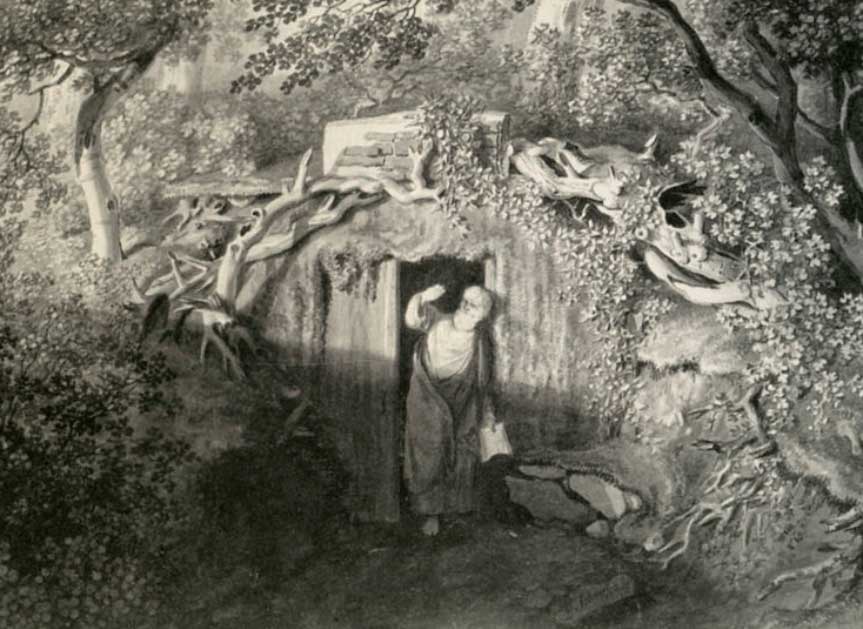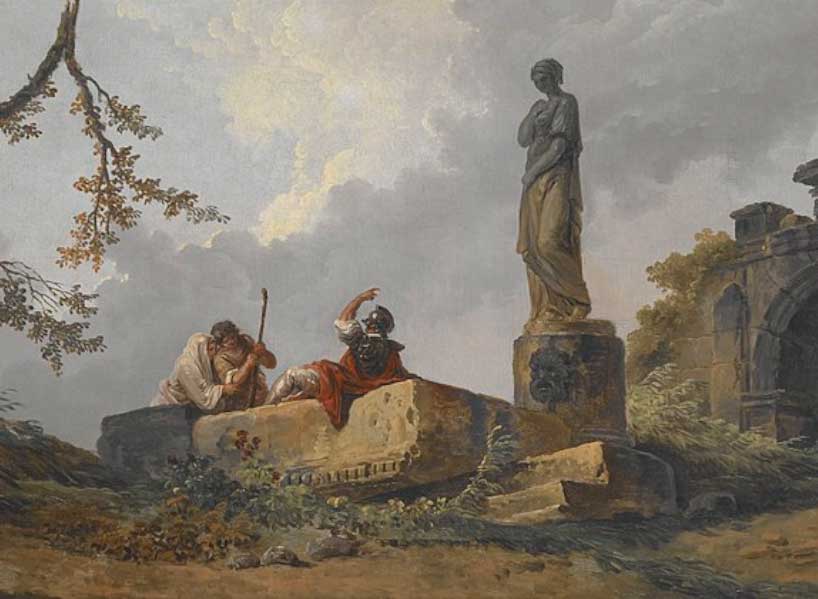Displays of wealth and prosperity have changed over the course of time. Today, having the latest mobile phone, owning the fastest and most luxuriant car or the biggest house, these all send messages to those who see them about our success, and our spending power.
However, there have been many weird displays of power and wealth from history that would amaze us today. One such display of wealth would be to employ an ornamental hermit, a person living a hermit’s life on a property just for decorative purposes.
Wealthy families in 18th century Britain, and indeed Europe, would often hire people to live in extremely basic conditions, like a hermit on their property, as a display of their wealth. A person appearing like a hermit, doing nothing, would apparently entertain their guests.
How the idea of ornamental hermits came about is not clear. However, some historians say that the idea came from Emperor Hadrian of Rome, who would often take refuge in a villa in the middle of a pond when the burdens of the Roman Empire would tire him out.
Background Decoration
The idea of having a personal hermit in the garden was an idea that was very popular for landowning families of Georgian England. The wealthy would keep a random stranger in their garden with long beards, minimal hygiene, and dressed in druidic clothes.
Hermits would also often be given a conical hat to wear, at the tie considered a “dunce’s” hat, but a decorative feature which may have given rise to the popularity of garden gnomes today. All this so that the hermit can pose in front of the guests when they come to visit.
The drive to keep an ornamental hermit was likely linked to the rise of ornamental gardening in England, where decorative gardens were adorned with ruins or “follies” pretending to be ancient. According to historical records, these ornamental hermits would not just impart a gothic air however.
The hermits would often also serve beverages and refreshments to people or recite poetry to entertain them. These hermits were also known to do minor agricultural work in the garden in an effort to blend in with their surroundings.

People of that era even constructed elaborate hermitages near their houses so that the hermit could stay inside. The guests would then visit the hermit when they came to visit the family. The hermitage would have an elaborate setup to portray the elements of mystery and mortality.
- Who was Dina Sanichar, The Real-Life Mowgli Raised by Wolves?
- Cold Hearted: Why Did Empress Anna Ivanovna Build An Ice Palace?
For example, the hermitage would have a sitting place for the hermit. The hermit would have a skull beside him and a book as symbols of mortality and wisdom. He would also have a pair of spectacles with him and an hourglass. Guests would often ring a bell outside of the hermitage and then go inside, where he would receive them.
Performance Art
Although the setup for these hermits was so elaborate, these were of course not actual hermits. Instead, these were performance artists, lucky enough to look the part and who were willing to become ornamental hermits for wealthy families.
These hermits would also have contracts, rules to follow, and salaries that they would draw for their act: it seems that even those looking for the simplest of lives could not escape life admin. In these contracts, his living condition and his time of residence would be clearly stated.
He would be told to wear a certain type of clothes to carry out his act, and that he would not cut his beard or go for any other kind of grooming activities. He was also obliged to limit his communication and movement, and hermits were generally not allowed to go beyond the property of the owner and also not allowed to talk to servants of the family.
The payment for the services of an ornamental hermit would come at the end of the contract period. However, seeing that the person would be given food, water, clothes, and residence by the family, it was not an uncomfortable arrangement to get the money at the end of the term.
While it may look like being an ornamental hermit was a strange career that not many would choose, this was not true. In 18th century England, many people became professional ornamental hermits because it was an easy life to lead. The career was great for people who wanted to retire from other jobs and laborious occupations, spending their days in solitude.
Why Were Ornamental Hermits Hired?
The idea of ornamental hermits came from a strange combination of circumstances, chiefly a romantic view of the past and the concentration of wealth amongst the landowning class. They had imperial precedent to draw on also, as the Roman Emperor Hadrian was known to live partially as a hermit himself, away from palace intrigue and weighty matters of state.
With Henry VIII’s conflict against the Catholic church saw most of the English monasteries and hermitages closed, people wanted to keep such figures alive in fiction and public life. Ornamental hermits, less religious and more decorative, may have arisen from such ideas.
- Peter the Wild Boy: Kensington Palace Beloved Resident
- Living the Lie: Who Was the Mysterious Man from Formosa?
Hermits had become rare at that time, which made them a novelty and a curio for members of the wealthy society. Many families kept ornamental hermits to capitalize on the curiosity and, at the very least, provide a talking point over dinner.
In the absence of real hermits, ornamental hermits filled in some figment of imagination for noblemen and affluent families. Their presence in society created a public discussion about their value, and led to a rise of the concept of a simple life, such as Hadrian had desired.

The practice of ornamental hermits came from the craze for ornamental gardens arranged to look like natural landscapes. These parks would also have many temple-like structures, stone bridges, and other buildings.
Small spaces built into tree recesses and other hidden places would provide carefully chosen viewpoints for these parks. Later, these structures were used by the wealthy people themselves as hermitage-like retreats where they could spend some time in solitude and peace.
However, as time passed, wealthy people took the phenomenon a little further. Instead of staying in these solitary structures for some time, they would hire people to stay as hermits in these artificial hermitage-like structures. The British people’s fascination with druid legends and history might also have inspired this idea of keeping people dressed like imaginary druid people.
Many people tried the career of an ornamental hermit, but not many were successful at it. Old people who were retiring were very successful in it. However, it was not easy to find a fake hermit who would say yes to all the clauses of the contract.
Sadly, it is not easy to be an ornamental hermit today. The practice died out in the 19th century, and would be seen as distasteful, expensive and outright weird now, although the job itself certainly holds some appeal.
But with the move away from landowners and great country houses, follies and decorative bridges, and the hermits who inhabited them, are now a thing of the past.
Top Image: Ornamental hermits would often feature in landscaped gardens. Source: Fotofrank / Adobe Stock.
By Bipin Dimri